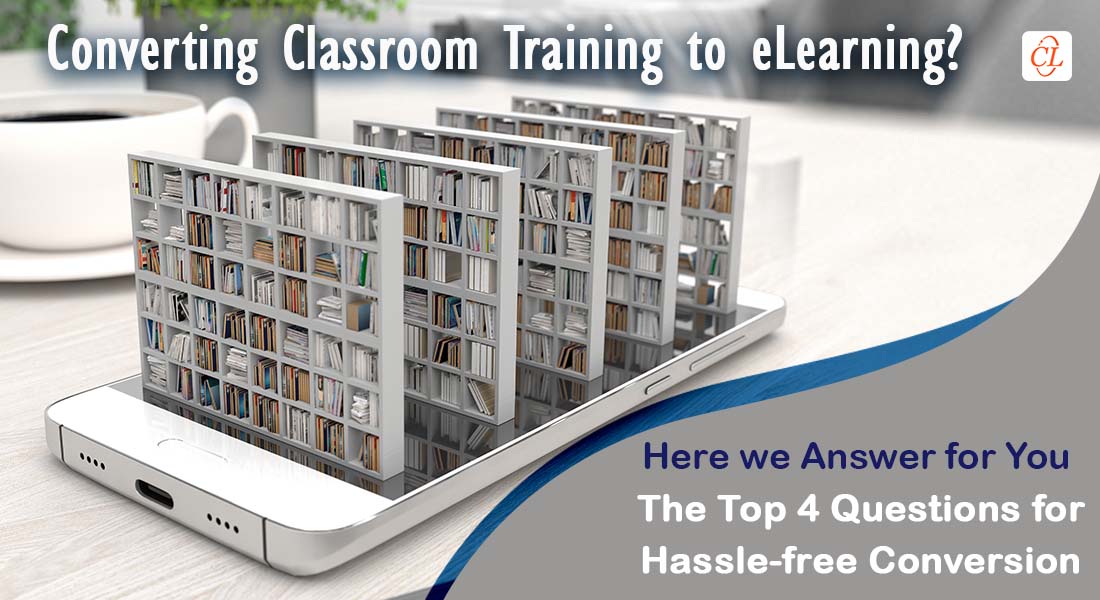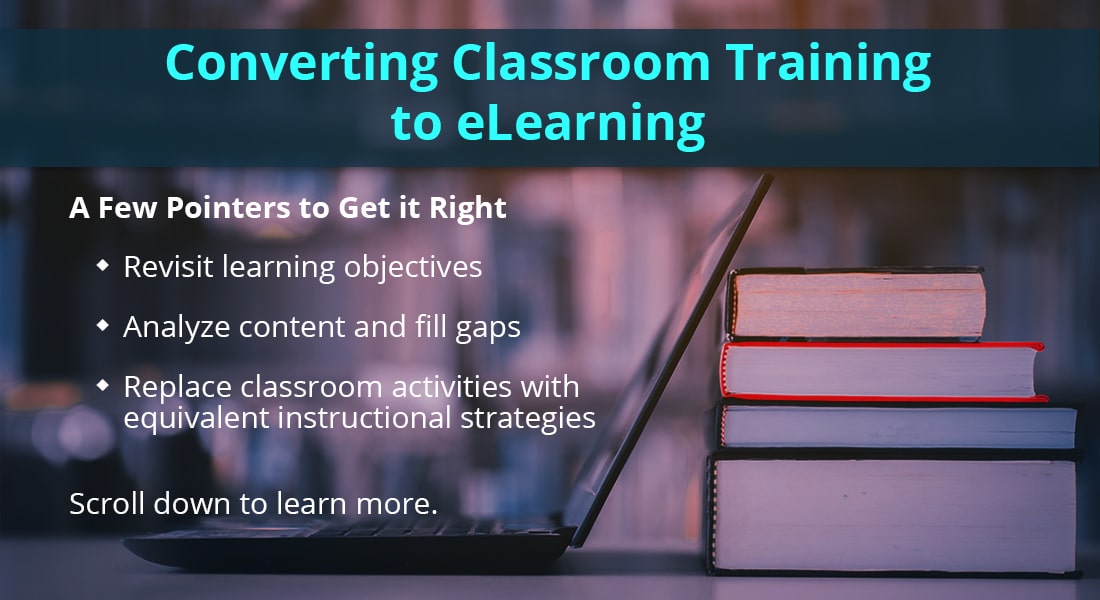Classroom to eLearning Conversion – Top 4 Questions Answered!

I am sure most of us have managed to survive through the classroom training sessions in the pre-pandemic times, as most of the organizations were using the traditional methods of training. However, post-pandemic there has been a 180-degree turn in the way we learn. Organizations had to start training their employees online, exactly when they realized how convenient and effective it is. Not forgetting to mention the obstacles they overcame, availability of trainers, gathering all learners at one place at the same time, cost and time invested in setting up the whole classroom and so much more. Online learning made it very easy for them to conduct training and saved time and cost too.
Now that we have left the days of chalk and duster behind, the next problem that arises is converting the classroom training into eLearning courses. So many questions were raised related to how can we do that. Well, let me answer the top 5 questions related to the classroom to eLearning conversion.
Converting Classroom Training to eLearning?
Here are the Top 4 Frequently Asked Questions:
- Can You Directly Convert Classroom Material Into eLearning?
- Which is Better? Converting to One Lengthy Course or Multiple Shorter Courses?
- Can You Use Classroom Material as a Base for Creating Performance Support Tools?
- Can You Use Classroom Material For VILT (Virtual Instructor-Led Training)
Read on to Explore Their Answers…
Can You Directly Convert Classroom Material Into eLearning?
Well! To answer this question let us first understand the difference between the classroom training material and eLearning courses.
Classroom material includes lengthy narratives and in-depth explanations related to the subject. However, that is not the case with eLearning. eLearning is not just plain text on a computer screen, it is a whole learning journey and a learning experience. eLearning courses should be interactive and immersive to keep the learners engaged throughout.
So, the answer to the above question is NO.
You cannot just automatically convert the classroom material to eLearning. Both of them are very different from each other. What eLearning can capture from classroom material is its essence. We can go through the classroom material, take out the gist, frame the learning objective, and then create an eLearning course based on that. Creating an eLearning course will require:
- Good instructional design
- Taking the essence of classroom training and converting it into eLearning.
- Rapid development and authoring tools expertise.
Hence, converting your PDFs or guides into a PowerPoint presentation may not be the right thing to do. eLearning is all about creating a successful learning journey to capture learners’ attention and make them attain knowledge or a new skill.
Go through the webinar recording to find out how you can replicate classroom activities in the virtual space
Which is Better? Converting to One Lengthy Course or Multiple Shorter Courses?
What if I ask you to read a whole book in one day and also attain a skill from that? Next, I ask you to read the same book in a week, at your own pace, and at the same time, I make the book more interesting. What will you choose? Of course, the latter.
Coming back to our question, employees prefer multiple shorter courses or smaller microlearning modules over lengthy standalone courses. eLearning curriculum offers you many more benefits than standalone courses.
- Better retention
- Better completion rates
- Anytime anywhere accessibility
- More flexibility
- Better learner engagement
Microlearning modules would be a boon to your modern workforce, they are a mobile-friendly generation and microlearning offers you the freedom to take courses anywhere, anytime, and from any device.
Can You Use Classroom Material as a Base for Creating Performance Support Tools?
As we know that the classroom material provides in-depth explanations and long narrations, which is not exactly what is required from performance support tools. Performance support tools are used to provide specific information that is required to complete a specific task.
Coming to the question. Yes, you can use classroom material as a base to create performance support tools, however, you will have to skim the fat. The key is to differentiate between nice-to-know and need-to-know information. You cannot use the classroom material as is. You will have to spend some time understanding the information that is required and then convert it to your preferred eLearning format.
Can You Use Classroom Material For VILT (Virtual Instructor-Led Training)
Now both classroom training and VILT have one thing in common and that is they both require a trainer. However, the major difference between them is where they take place. In classroom training, it is easy for an instructor to assess the mood of the audience and mold the training accordingly, whereas a virtual instructor does not have that privilege.
To answer the question, yes you can use the classroom material for virtual instructor led training but you cannot use it as is. You will have to design and deliver the training according to the training needs of the virtual audience.
- You will have to convert the classroom activities into online collaboration activities.
- As the trainer cannot assess the attentiveness and mood of the learners, it will be important to add elements to engage the learners like usage of the chat window, emoticons, poll questions, in-class quizzes, etc.
- You can also add a host or a moderator who could be present in the session to help the trainer with extra activities like operating tools, creating breakout rooms, etc. This way the trainer can focus on training only.
Parting Thoughts!
Hope you had all your major questions answered. To conclude, your classroom training material might contain some very important information that is required by the learners. However, the key is to use the classroom material effectively and efficiently. It is important to differentiate between the information that is good to have and the information that is a must!
Now that you know what material can be converted into virtual training, let us give you some tips on how to generate motivation and excitement in the virtual classroom. Grab this free eBook to know more.





